
Search
Category
Area
Season
-
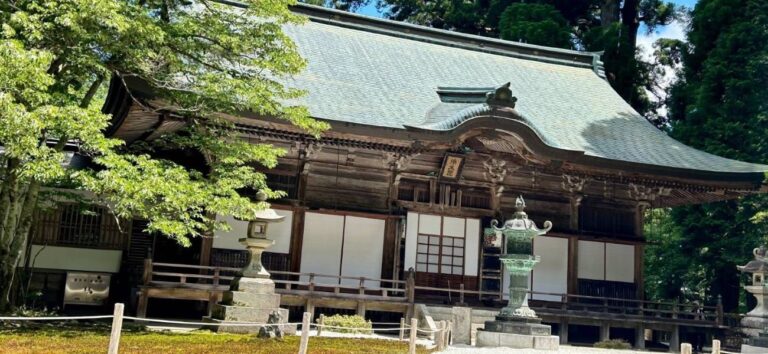
Tailored ascetic training experience at the World Heritage site of Mt. Hiei Enryakuji Temple
Enryakuji Temple on Mt. Hiei is a religious institution that is renowned for producing famous monks, such as Honen and Shinran, from various schools of Japanese Buddhism. Many monks continue to engage in various forms of ascetic practices on the temple grounds.
The experience involves the following:
・ Participants will be guided by the chief priest (the current instructor of monks-in-training) of Enryakuji Temple, one of the most famous Buddhist monasteries in Japan and a World Heritage Site.
・ Each participant will speak with the chief priest, who will ask about their daily thoughts and worries to determine the most suitable training.
・ The training is identical to that practiced by many monks today:
- Circle the mountain in kaihogyo, an ascetic practice that has performed by monks at Mt.Hiei for the past 1100 years
- Practice seated hoto-zazen meditation while visualizing the 1,200-year ""eternal flame of Buddhism""
- Clean the temple grounds and dojo to clear your mind and attain a meditative state
- Recite the name of Amitabha Buddha in Amitabha samadhi, one of the four kinds of samadhi practiced on Mt. Hiei
In contrast to the tourist-oriented training experiences of the past, we offer an authentic training experience in which participants will attain new understanding and insights. -
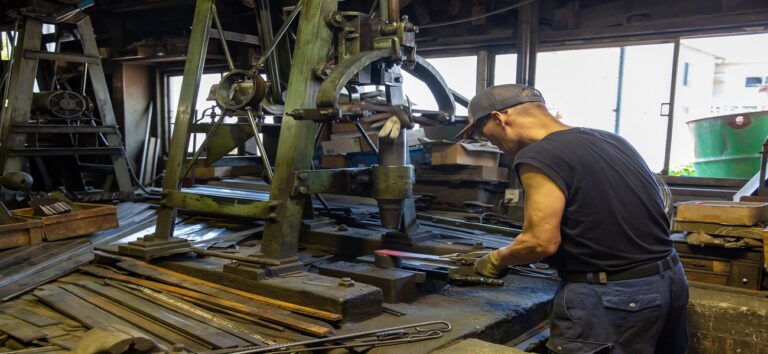
Stay in Echizen and Try Your Hand at Making Hammered Blades and Japanese Umbrellas Under the Instruction of Traditional Artisans
Learn traditional crafts from craftsmen and artisans who have preserved and passed down the traditional industries of Fukui Prefecture's city of Echizen for generations. In this program, you will have the opportunity to make your own one-of-a-kind traditional craft items.
Learn how to make Echizen hammered blades from the artisan Takeshi Saji in a workshop not usually open to the public. Next, the artisan Naganobu Komamoto will teach you how to apply maki-e lacquer decoration to the handle to match the knife made in the workshop.
Artisans will also teach you the meticulous art of making Japanese umbrellas using Echizen washi paper.
Back at your accommodation, you can try your hand at cooking shabu-shabu using renowned Wakasa beef from Fukui Prefecture.
On each part of the tour, you will be accompanied by a professional interpreter.
Private hire cars are also available for transport from the meeting point and the accommodation. -
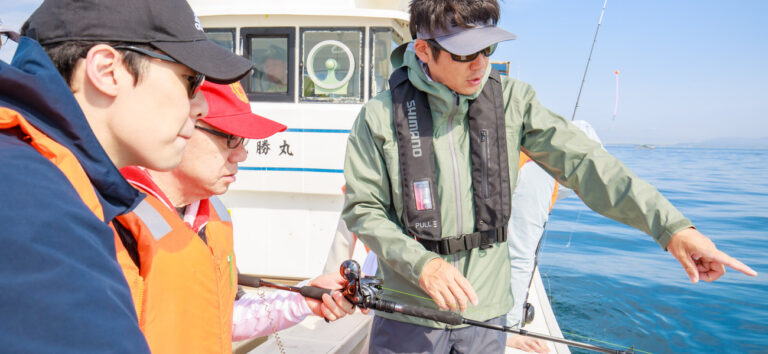
A Fishing Tour Where You Will Learn How to Maneuver a Boat, Read the Tides, and Catch Fish
● Even beginners have a high chance of catching fish, as you will be accompanied by highly skilled boatmen and professional anglers certified by fishing tackle manufacturer Shimano.
● All fishing equipment is provided: you can show up to the tour empty-handed!
● Any fresh fish you catch will be cooked and served to you at the restaurant.
● Stay at a five-star hotel in the Umeda or Namba areas of Osaka.
● Take a hired car to and from the hotel to the fishing port.
● Enjoy shopping at a popular roadside station in Misaki, where you can buy fresh local vegetables and fish. -
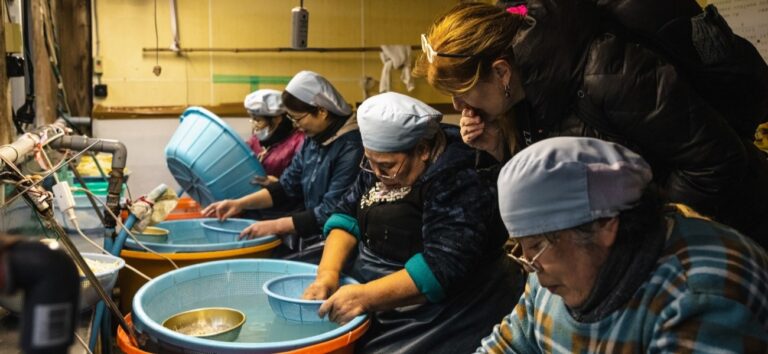
Hokuriku-Echizen Grandmaster Tour
The Hokuriku area is home to a large number of traditional folk crafts, 23 of which are nationally recognized. All have a long history, and have been carefully handed down to the present day.
The Tannan district in the Reihoku area of Fukui is truly unique, with five nationally designated traditional craft centers concentrated within 10 kilometers of each other. One such craft is Echizen washi paper, which has a 1,500-year history and is said to have been used by world-famous painters like Rembrandt and Picasso. Toyama is surrounded by the Tateyama mountain range, which provides easy access to high-quality timber, and many crafts that utilize wood have flourished there. Inami, a town known for sculptures, was recognized as a Japan Heritage site in 2018. Home to 36 traditional folk crafts, Ishikawa is also known as the “kingdom of crafts.” Ishikawa is particularly well known for its 10 traditional crafts specially designated by the Japanese government, and has it produced a remarkable number of artisans who are recognized as Living National Treasures.
Interact with the grandmasters of these nationally designated traditional crafts, whom tourists typically never get the opportunity to meet, and tour their workshops that are usually closed to the public. Enjoy a special dining experience in collaboration with area chefs which showcases local ingredients and makes use of the craft items crafted by these grandmasters. -
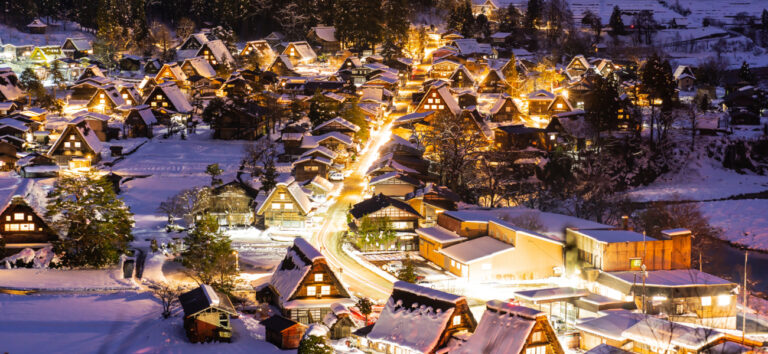
Tour for Luxury Tourists: “The Path of the Craftsman—A Journey Through the Heart of Japan”
This tour is an in-depth experience of traditional Japanese crafts, natural landscapes, and culinary culture unique to various areas. The following unique experiences will be offered in the Aichi, Gifu, and Kyoto Prefectures.
(1) Traditional folk craft experiences
- Ceramic art: Learn from the direct apprentice of a Living National Treasure at the Kobeigama Kiln for an authentic Japanese experience. This activity is exclusive to participants of this tour, and the items can be mailed back to your home countries at a later date.
- Small blade making: Try your hand at making a small blade in a workshop not usually open to the public in Seki, Gifu Prefecture. This experience is also exclusive to participants of this tour, and items can be mailed back to your home countries at a later date.
- Mino-washi papermaking: Learn from an artisan how to make hon-minoshi paper, a method which is registered as an Intangible Cultural Heritage by UNESCO.
(2) Traditional scenery and accommodations
- Tour historical buildings: Visit traditional buildings in places like Gifu Prefecture's Takayama City, Mino City, and Shirakawa-go, as well as Kyoto Prefecture's Kyoto City. Enjoy strolling around and taking photos wearing a kimono.
- Traditional accommodations: Stay in select accommodations in old private homes built more than 130 years ago, or in machiya-style townhouses designated as Important Cultural Properties by the Japanese government. Enjoy an extraordinary experience in a truly special space.
(3) Culinary culture and seasonal produce
- Michelin Guide-listed restaurants: Enjoy dishes made with seasonal local ingredients, such as wild vegetables in spring, ayu (sweetfish) and eel in summer, matsutake mushrooms in fall, and wild game in winter. Accommodations can also be made for vegan or halal dining.
Participants will be accompanied by a guide from the region who is fluent in the participants' language, has extensive knowledge of the area, and who can provide a deeper understanding of Japanese culture. -
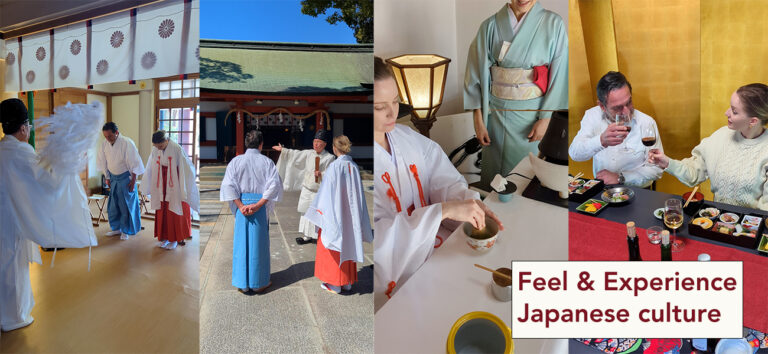
Exclusively Reserved Tour
Discover Ōyosami Jinja Shrine, where the gods of Japan have been worshiped for more than 2,000 years. Participants will be picked up from their hotel in Osaka by taxi to make traveling to the shrine stress-free. Upon arrival, you will be greeted by a priest and make your way under the shrine's stone torii gate to begin this special program. First, you will don the robes of a Shinto priest and perform a formal shrine visit and prayer. The priest guide will then provide a detailed explanation of Japanese shrines and the Shinto faith that underpins the spirituality of the Japanese people. Afterwards, you will visit other areas of the shrine grounds, including a sacred "shinboku" tree.
After the Shinto experience, you will enter the sacred space of the Kaguraden for a special tea ceremony experience. After changing back into your clothes, try your hand at Japanese calligraphy.
All these participatory experiences are conducted by qualified professionals, allowing participants to learn about Japanese culture in-depth.
After these special lessons, participants will enjoy a kaiseki-style bento, a beautifully presented Japanese meal made with seasonal vegetables. Japanese sake and wine will also be available to pair with the dishes.
After the program is over, participants will be taken back to their hotel in Osaka.
Reservations must be made in advance for this tour. A dedicated guide and interpreter will be present throughout the tour, and the shrine will be booked out exclusively for the program. This will ensure you gain a better understanding of each cultural activity for a truly memorable Japanese experience. You may also ask any questions you may have about Japan. -
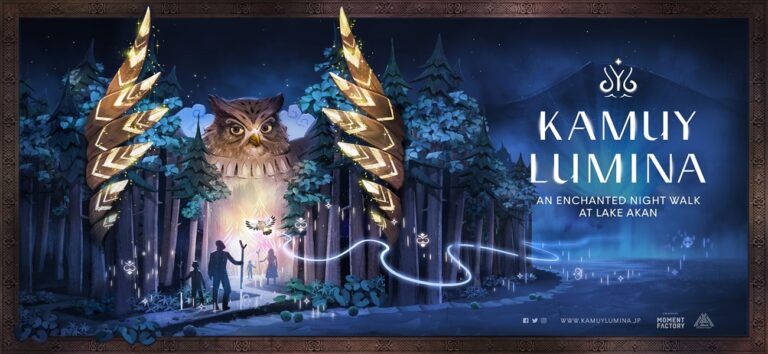
Kamuy Lumina: Lake Akan Forest Night Walk
Nighttime entertainment at Japan's first national park.
Kamuy Lumina: Lake Akan Forest Night Walk is an adventure tour pursuing the world of the Kamuy (spirit-deities) that were inspired by the yukar tale “The Tale of the Owl and the Jay Bird,” a legend of the Ainu people of Akan.
The setting is Lake Akan, located within Hokkaido’s Akan-Mashu National Park. Starting at dusk, this dream-like experience along the Bokke Walking Trail 1.2 kilometers from the lake’s shores will let you get in touch with Ainu culture.
You are invited to the national park’s natural forest to soak up the Ainu worldview of valuing coexistence with nature, but with a twist: this tour features cutting-edge digital art, including projection mapping, scenography (light and sound stage sets), and a unique musical experience with rhythm sticks.
A multilingual app has been developed so that people all around the world can deepen their experience and learn about Ainu culture. Additionally, there are special programs to help you feel at one with the Ainu people, such as a private event where you can don original Ainu hanten robes with patterns approved by the Akan Ainu community.
The Kamuy Lumina is one of a series of Lumina night walks developed around the world by Moment Factory, a cutting-edge multimedia entertainment company based in Montreal, Canada, and Lake Akan is the only location in the world where a national park is being used as the stage. -

Beginners Adventure Tours
[Course A]
・Spectacular views! Zip downhill on an e-bike from Bihoro Pass overlooking a caldera lake (Lake Kussharo) in Akan-Mashu National Park (electric-assisted bicycle tour)
・Kayak along the Wakoto Peninsula, a place of boiling hot spring water, before coming ashore to experience the volcano in Oyakotsu Jigoku
・Eat a special homemade lunch using locally-produced ingredients on the shore of Lake Kussharo
・There is also an additional mini-cycling tour available, going by e-bike through agricultural, mountain, and fishing villages to Sunayu for a footbath in the hot springs
・Our final destination is Mt. Io, a geopark where you can feel the real pulse of Hokkaido's Tomoshiri
[Course B]
・Start from Omagari Lakeside Park, a field used by inmates of the former Abashiri Prison (the sunflower and cosmos flower gardens are at their best in August and September!)
・Take a leisurely ride on an e-bike along a bike path that uses the old Kushiro Line with Lake Abashiri at its side
・The coral grass with their bright red leaves that bloom in autumn at the brackish Lake Notoro are at their best in September
・Cycle by e-bike in the magnificent rural landscapes overlooking Cape Notoro
・Cross a sea relic lake! Kayak on Lake Notoro, Abashiri Quasi-National Park
・Cycle by e-bike to Cape Notoro Lighthouse while overlooking the Sea of Okhotsk where ice drifts and re-emerges!
・Have lunch at Connectrip, a hands-on facility at Lake Abashiri, where you can bake your own pizza! After stretching out the dough and topping it off with your favorite local ingredients, bake it in the stone oven for your very own stone-baked pizza! -

Ascetic Training, Senchado Tea Ceremony, and Fucha Cuisine at Manpukuji Temple
Manpukuji Temple was founded in 1661 by the Chinese monk Ingen Ryuki and is the head temple of the Obaku sect of Zen Buddhism. It is characterized by its Chinese-style architecture, in which its seven halls are arranged in the Ming Dynasty style.
The Daio Hoden Main Hall—the only one made of teak in Japan—the Dharma Lecture Hall, the Kaizando Founder’s Hall, and more, still stand as originally constructed. Highlights of the temple also include its Important Cultural Properties, which consist of twenty-three main buildings, corridors, plaques, and hanging couplets.
You can also experience the Chinese culture of the time through the temple's collection of Buddhist statues, framed inscriptions, paintings on sliding-door panels, and hanging scrolls by Buddhist artists from China.
Zen Master Ingen introduced a great number of things to Japan, many of which are taken for granted today. Such imports include kidney beans, watermelon, lotus root, sencha green tea, bamboo shoots (moso bamboo), chairs, tables, and manuscript paper.
Fucha cuisine, the Chinese version of Japanese Buddhist Shojin vegetarian cuisine, is beautifully presented and tastes divine. It is one of the highlights of the event that allows guests to truly experience Chinese culture.
There are Zen monks at Manpukuji who continue to practice asceticism to this day. These monks devote themselves to their practice through zazen meditation, Zen dialogue, religious services, alms begging, and other daily temple work at the Zen dojo located on the temple grounds. Visitors can deepen their understanding of the history and culture of Manpukuji from a digital guide available in seven languages: Japanese, English, French, Spanish, Korean, and Chinese (simplified and traditional). -
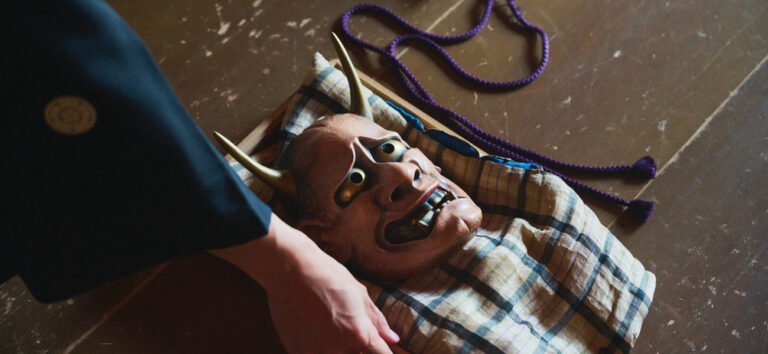
Tokyo | Intensive Noh Masterclass
Theater steeped in spiritual traditions
Austere, meditative, and steeped in spirituality, Noh Theater is one of Japan's oldest performing arts and a recognized UNESCO World Cultural Heritage. Characterized by masks that carry a multitude of emotions within a single carved expression, Noh performances consist of rhythmic chanting, slow, measured movements, and an iconic stage adorned with a painted pine tree that mimics outdoor structures.
In this Noh Masterclass, you will receive a comprehensive introduction to the world of Noh - from its history to performing styles, masks to costumes - from a 4th-generation Noh performer at his private residences. Walk across the sacred stage, witness performances up close, and experience the indescribable elegance of Noh Theater.
